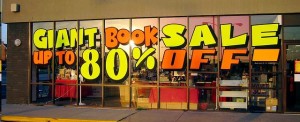 Continuing with my book on lead generation using a free book…
Continuing with my book on lead generation using a free book…
The chapter I intended to write today was growing too long. This section was originally in the middle of it, but I realized it makes a great short chapter or supplemental section on its own. So I’ve broken it out and it’s today’s email!
—
Should you sell your lead generation book, or give it away?
Before we dig into the actual funnel itself, there’s a critical question you want to answer. Are you going to make prospects buy the book? Or are you going to give it to them free?
If you make them buy it, you’ll significantly reduce the number of total prospects you get from your campaign. That said, that’s not necessarily a bad thing. Those who are willing to spend a little bit of money up front will most likely be the best, most qualified customers for your service. You’ll have fewer leads to deal with, but the ones you have will be very high value.
On the other side of that equation is giving away your book totally free. In some very limited circumstances, I’d recommend giving away a free physical copy of your book. If you’re able to limit your advertising only to your most targeted prospects, this can be the best way to maximize the number that raise their hand and start a conversation with you. But if you are not careful with who you target in the first place, you’ll deal with an influx of poor quality leads who you have to pay to print and send your book to, with little hope of ROI.
The one exception would be giving away a free ebook. Because your cost for this is effectively zero, this might be a preferable route for you to take. However, as I said before, anything digital has a much lower perceived value. Also, what I’ve seen over and over again with my clients is that those prospects who get something they hold in their hand (rather than a digital copy of the book) consistently spend more, stick longer, and are better customers than digital-only customers.
So what route do I recommend?
The “free book plus shipping” offer is, by far, the best way to do this, in the vast majority of cases.
In online retail (think Amazon.com), giving free shipping was the coup that finally switched a large number of consumers over to buying online, rather than shopping locally. In fact, Amazon didn’t really explode in growth until Jeff Bezos decided to stop spending money on advertising, and divert all that money to paying shipping on all orders over $25.
The free book plus shipping offer flips the free shipping equation on its head. Rather than charging someone for the book, you offer to give them the book free. Because you’re not discounting, the book tends to hold its perceived value. Especially if it can be purchased through standard channels such as Amazon.com for retail price.
But you do want to cover your costs of shipping, and put up that same qualification barrier that you would achieve through charging for the book. And so you charge a relatively nominal shipping and handling fee, in order for the customer to get the book free.
This shipping and handling fee runs anywhere from a couple bucks to as high as $10 or more. I tend to prefer somewhere in the middle, and base it on the size and retail price of the book. My sweet spot for a book under 100 pages is $4.99. This goes a long way to offsetting the cost of shipping and printing the book (though not totally), and it definitely narrows down the field to qualified prospects without thinning it out too much. You may want to test with your market.
This is based on the “self-liquidating lead generation” concept from direct marketing best practices. The idea is that you don’t want to make a bunch of money off of lead generation, but you don’t want to lose it, either. Especially when you have legitimately created a valuable book that will indeed be helpful to your prospect, in addition to its role as a sales tool.
Yes, you do have to work a little harder to sell the book if the prospect has to pull out their credit card to order. However, the prospects that do pay a little to get the book shipped to them will be more engaged, and more likely to consume it when they get it. By paying, they will be more motivated to get their value out of it.
—
Yours for bigger breakthroughs,
Roy Furr



